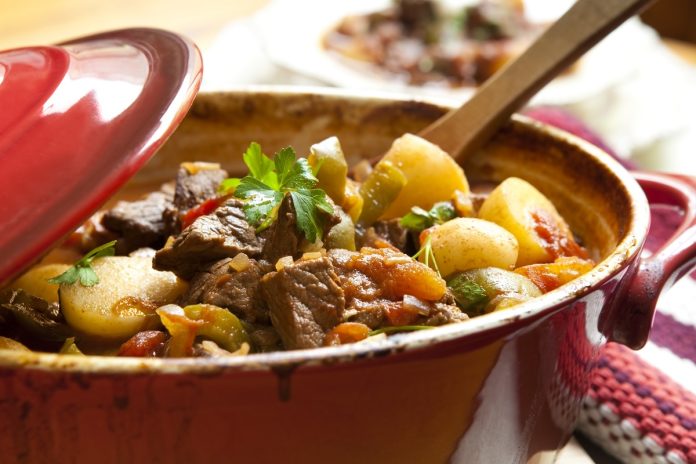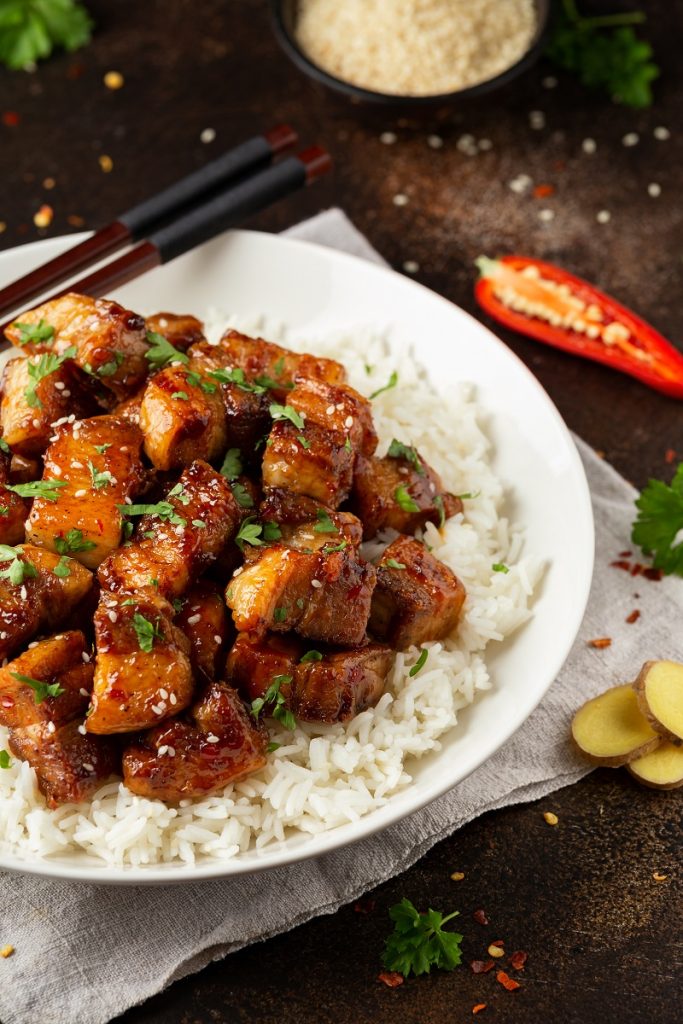
It’s safe to say that most Caribbean cooking is filled with bold flavor and a heavy hand on the spice. But for those looking to satisfy their craving for homestyle, savory meals with an island flair, authentic Haitian food is particularly inviting. Haitian cuisine tends to follow Creole traditions and practices, with complex flavors packed into marinated meats, seafood, stews and veggies, typically all topped off with a blend of fresh herbs, onions, garlic and peppers in the form of Haitian Epis.
As one of the islands originally inhabited by the indigenous Taino, Haiti has kept many of the gastronomic traditions of their ancestors, and the diaspora has continued to pass down family recipes from generation to generation, which is likely why Haitian cuisine is often described as “soulful.”
Cooking is one of the easiest ways that people can reconnect to their culture. So, whether you’re looking to get back to your roots or you’re experimenting with the island’s cuisine for the first time, this Haitian Heritage Month try out these five authentic Haitian recipes that will make any foodie’s mouth water.
Soup Joumou
One of the most easily recognizable (and looked-forward-to) Haitian dishes might be Soup Joumou, a thick and hearty squash-based stew that is typically reserved for special occasions, holidays and Haitian Independence Day. This dish has a complex past as a meal that was served for plantation owners but never allowed to be eaten by slaves. When freed, Haiti adopted this dish as its unofficial independence meal. This recipe makes a LARGE quantity, so prepare to enjoy this meal with friends and family gathered around the table.
What you need
- 1 cup white vinegar
- 1 pound beef shank, cut into 1 inch cubes
- 1 pound boneless beef chuck, cut into 1 inch cubes
For the marinade
- 1 cup Haitian Epis seasoning (store bought or homemade)
- 2 ½ tablespoons fresh lime juice
- 1 tablespoon lemon juice
- 2 teaspoons salt
- 1 teaspoon pepper
For the stew
- 15 cups vegetable broth
- 2 tablespoons tomato paste
- 1 butternut squash, peeled and cut into 2 inch pieces
- 2 large russet potatoes, chopped
- 3 carrots, sliced
- ½ small green cabbage, chopped
- 1 yellow onion, sliced
- 1 celery stalk, coarsely chopped
- 2 scallions, chopped
- 1 green Scotch Bonnet Pepper
- ½ teaspoon onion powder
- ½ teaspoon garlic powder
- 1 thyme sprig
- 1 pinch of cayenne pepper
- 3 teaspoons kosher salt
- 1 teaspoon freshly ground black pepper
- 1 one-pound box of thick cut pasta
What to do
- Make your marinade by stirring together the Epis, lime juice and salt into a large bowl. Set aside for now.
- Pour vinegar into a large bowl, add in your beef and swish it around to sanitize. Transfer the meat to a colander and rinse thoroughly with water.
- Add your beef to the marinade bowl and stir to coat. Leave the meat to marinade for at least three hours, preferably overnight.
- In a large pot over medium heat, add 5-6 cups of broth and your marinated beef. Cover and simmer for 30-45 minutes or until beef is tender. Add in your squash, cover and simmer together for another 20 minutes or until the squash can be easily pierced.
- Transfer the squash to a blender, add about 4 cups of broth and puree. Return to the pot and add the remaining broth, tomato paste, potatoes, carrots, cabbage, onion, celery, scallions and pepper. Let simmer, then increase the heat and add your spices and pasta. Reduce heat to medium and simmer uncovered until pasta is al dente, about 8-10 minutes.
- Taste and adjust, then serve and enjoy!

Pikliz
Another iconic part of Haitian cuisine is Pilkliz, a delicious island-inspired pickled vegetable relish. Though this is typically eaten as a side with fried foods, we had to put it on our list as a classic favorite for a spice-packed dish that will leave your taste buds wanting more.
What you need
Ingredients
- 1 cup red cabbage, shredded
- 1 cup green cabbage, shredded
- 2 Scotch Bonnet Peppers, sliced
- 1 large red bell pepper, diced
- 1 cup onion, sliced
- ½ cup carrot, grated
- 4 cloves garlic, minced
For the brine
- At least 1 large mason jar (64 ounces or higher)
- 1 ½ cups apple cider vinegar
- ½ lemon, juiced
- 1-2 teaspoons Kosher salt
- ½ teaspoon black pepper
What to do
- In a large bowl, whisk all of the brine ingredients together. Set aside for now
- In a separate large bowl, mix all of the vegetables together. Add them into a large mason jar (or two if more space is needed). Pour the liquid mixture into the jar until all vegetables are completely covered.
- Shake the jar to ensure even more coverage, then secure the lid tight and refrigerate for 3-5 days.
- Take out of the fridge, serve with your favorite main dish and enjoy!
Haitian Griot
If you’re needing a main course to have alongside your Pikliz, one of the best options is Haitian Griot! A savory and citrusy blend of herbs, spices and marinated pork combine to create one of the most recognizable (and ordered) dishes at any Haitian restaurant — and rightfully so as griot is often considered Haiti’s national dish. But Haitian families rarely get it when out because each has their own secret recipe that has been passed down for generations. Now you can make it at home too.

What you need
- 3 pounds pork shoulder, cubed
- Salt and pepper, to taste
- 1 yellow onion, chopped
- 3 shallots, chopped
- 4 cloves garlic, minced
- ½ bell pepper, diced
- 3-4 scallions, chopped
- 1 chicken bouillon cube
- 1 Scotch Bonnet Pepper, sliced
- 2 oranges, juiced (about ¾ cup)
- 4 tablespoons fresh lime juice
- 1 tablespoon white wine vinegar
- 1 cup of fresh parsley leaves
- 8 sprigs fresh thyme
- 2 cups water
- Vegetable or canola oil for frying
What to do
- In a large bowl, add the cubed pork, salt, pepper, and your veggies (onion, garlic, scallions, shallots, bell pepper, Scotch bonnet pepper). Mix, then add in the chicken bouillon cube, orange and lime juices, white wine vinegar and the thyme and parsley sprigs.
- Mix the ingredients thoroughly — with your hands is the most effective method, but using a spoon is sufficient too. Cover with saran wrap, then place in the refrigerator to marinate for at least three hours, preferably overnight.
- On the stove, add your marinated meat into a Dutch oven and place on high heat. Add water and bring to a boil. In the meantime, preheat your oven to 350° F. Once at a rolling boil, remove from heat and transfer the Dutch oven into the oven to braise. Leave for about 90 minutes or until the pork is tender.
- Once cooked, remove from the oven and pick out the pork, saving the rest of the vegetable mixture to the side. Place the prepared pork onto a paper towel-lined tray and pat down until completely dry.
- Add a large pot of oil to the stove over high heat until the oil is sizzling. Add your pork cubes in batches and fry until a dark golden brown, about 5 minutes.
- Transfer the fried pork to a paper towel-lined plate to remove excess oil. Serve with Pikliz, rice, beans and plantains and enjoy!
Poul Ak Nwa
Our next gastronomic delight is a popular Sunday night dinner that usually gets started right after morning mass. Don’t let the long ingredient list and time commitment scare you off though, this Poul Ak Nwa is worth all of the time and effort. Literally translating to “cashew chicken,” this flavorful dish combines chicken, vegetables, spices and more on top of a bed of jasmine rice.

What you need
- 1 cup raw cashews
- 2 pounds bone-in skinless chicken thighs
- ½ red bell pepper, chopped
- ½ green bell pepper, chopped
- 1 yellow onion, coarsely chopped
- 6 garlic cloves, chopped and neary minced
- 2 scallions, chopped
- ½ cup fresh parsley leaves, chopped
- 1 teaspoon dried thyme
- 1 Scotch Bonnet Pepper
- 3 cloves
- 2 tomatoes, finely chopped
- 2 tablespoons tomato paste
- ¼ cup extra-virgin olive oil
- 2 tbsp fresh lime juice
- ¼ cup apple cider vinegar
- Salt and pepper, to taste
What to do
- In a small to medium size saucepan, bring 3 cups of water and the cashews to a boil. Once at a rolling boil, reduce the heat to low, cover the pan and simmer for around an hour. The cashews should crumple but not disintegrate. Drain and set aside for now.
- In a large pot or Dutch oven over medium heat, add the chicken, garlic, cloves, lime juice, parsley, thyme, and salt and pepper. Mix until the chicken is fully coated.
- Add the Scotch Bonnet Pepper into the center of the pot and cover. Simmer for about 30 minutes, or until the chicken is almost cooked through. Transfer the mixture to a large bowl, making sure to keep the Scotch Bonnet Pepper intact.
- Then, into the same pot, add some oil and return only the chicken, stirring until golden brown. Reduce the heat to low.
- Add in the tomato paste and tomatoes and cook until soft.
- Add in the crushed cashews, Scotch Bonnet Pepper and reserved garlic, cloves, lime juice, parsley and thyme mixture. Stir, then cover and simmer for about 20 minutes or until the chicken is falling off the bone. Remove the Scotch Bonnet Pepper.
- Serve over white or jasmine rice and enjoy!

Haitian Street Beignets
Considering Haiti’s long and turbulent French ties, it’s no surprise that some remnants of the culture stayed, particularly intertwining itself with the cuisine. A prime example of this is Haitian beignets — a rarely enjoyed treat that is often only present between the start of Carnival celebrations until Mardi-Gras day. Delicious pastries typically made from fried dough, the Haitian beignet is actually created from a banana batter and are flatter than the traditional puffed variety. However, they are just as good (maybe better!), and just as decadent (maybe more!).
What you need
- 3 very ripe bananas
- 1 cup flour
- ¼ teaspoon baking soda
- ¼ teaspoon Kosher salt
- 1 cup water (milk can be substituted for a thicker consistency)
- ⅓ cup sugar
- ½ teaspoon vanilla extract
- ½ teaspoon cinnamon
- ¼ teaspoon nutmeg
- Vegetable or canola oil for frying
- Powdered sugar, for coating
What to do
- Peel and mash the bananas in a large bowl until they reach an oatmeal consistency.
- In a mixing bowl, add in flour, baking soda and salt. Create a well in the middle, then add the banana mixture and combine.
- Add in the sugar, vanilla, nutmeg and cinnamon. Add the water last and mix well until a batter forms.
- In a large pot or Dutch oven, heat your oil until it is sizzling.
- Using a large spoon, pick up the batter by the spoonful and simply drop it into the oil. Flip the dough over in the oil every few minutes to not over fry or burn one side.
- Once golden brown, remove the beignet with a slotted or skimmer spoon and place onto a paper towel-lined tray to remove excess oil.
- While still hot, coat generously with powdered sugar. Let cool and serve!






























